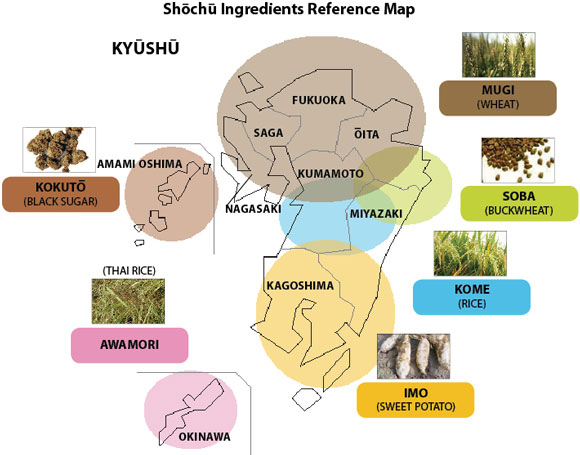Discovering Shochu: Episode 3 – Characteristics of Shochu by Ingredient
Honkaku Shochu, or traditional Shochu, represents Japan’s pride and true distillation art. Moromi mash created using koji spores indigenous to Japan, and the use of single distillation yields distinct flavor characteristics and refined aroma highlighting the original ingredient. And unlike many distilled spirits from around the world, there are various types of Honkaku Shochu differing in the base ingredients used.
Sweet potato, rice, barley, sugarcane, and buckwheat are some of the most commonly used ingredients.
IMO/SWEET POTATO
In the past, Imo Shochu or sweet potato Shochu was once the ruler of the Shochu world, with particularly strong accents that appealed to die-hard Shochu fans. However, in modern times, distillers turned to offer a more refined and delicate brew to suit today’s modern consumers where once, it was the most preferred among women drinkers. To further add interest, distillers use different varieties of sweet potatoes, some which are premium grade, then process them either whole or peeled, steamed or even roasted, to differentiate their product from others. SATSUMA SHIRANAMI, produced by Satsuma Shuzo, has a clean flavor with a delicate sweetness of sweet potato. Its sister product KURO SHIRANAMI, uses kuro (black) koji mold, and is known for its sweet flavor with depth.
ENJOYING SWEET POTATO SHOCHU:
(1) Light & Refreshing:
Serve on the rocks. Pairs well with light appetizers and fish.
(2) Sweet & Elegant Aroma:
Serve on the rocks to fully enjoy the sweet and elegant aroma reminiscent of ripened fruits and sweet potato pie. Similar to Ginjo premium sake, this sweet potato shochu is recommended for beginners.
(3) Full-bodied:
Mix with warm water to fully enjoy its round flavor similar to steamed/dried sweet potato. Pairs particularly well with Kagoshima cuisines, such as Satsumaage fried fish cake, kurobuta, tonkotsu and bonito dishes.
(4) Robust & Full-bodied:
Mixing with warm water is the standard way to drink, but it is also quite good on the rocks as well. Complements rich food, as well as grilled/roasted fish and meat dishes with a little bitterness.

KOME/RICE
Kome Shochu or rice Shochu started in the Hitoyoshi basin of the Kuma region in Kumamoto Prefecture. Kome Shochu is the original Shochu from which other types branched out, and therefore is considered the “Mother of all Shochu”. The typical rice Shochu from this area has an elegant aroma of grains, and a distinct rice flavor that is sweet and mellow. In recent years, a majority of rice Shochu are produced using vacuum distillation units, which tend to produce even lighter flavors with abundantly elegant aroma. Takahashi Shuzo’s HAKUTAKE SHIRO, with its elegant aroma of rice and light mouth-feel, is the No. 1 selling rice shochu.
ENJOYING RICE SHOCHU:
(1) Light & Refreshing:
Can be served in various ways. Very versatile in terms of food pairing as well.
(2) Fruity & Aromatic type:
Similar to Ginjo premium sake. Enjoy before or after meal on the rocks or mixed with cold water.
(3) Robust & Full-bodied:
Mixing with warm water is the standard way to enjoy this type of rice shochu. Complements slow-simmered fish, miso flavored dishes, as well as smoked meat and fish.

MUGI/BARLEY
With the highly recognized IICHIKO 100% barley Shochu, Sanwa Shurui of Oita Prefecture is the brewery behind the recent Honkaku Shochu boom. Its light and fruity flavor revolutionized the old notion of what once was “Shochu as an old man’s brew”. Recent consumer popularity shows growth in barley Shochu with roasted barley aroma, as well as barrel-aged types akin to whiskey.
ENJOYING BARLEY SHOCHU:
(1) Light & Refreshing:
A majority of 100% barley shochu produced in Oita Prefecture, like IICHIKO, fall under this category. Very versatile, and can be enjoyed in various ways with a wide variety of dishes. Holds the highest consumption share among all shochu categories.
(2) Savory & Rich Aroma:
Has the strong aroma reminiscent of roasted barley, coffee beans and bitter chocolate. Best consumed on the rocks after dinner, or paired with grilled dishes.
(3) Full-bodied:
Many of the barley shochu produced using rice koji, such as Iki Shochu, fall under this category, known for its firm body and mellow flavor with depth. Adding a little warm water is the standard way to enjoy this type of shochu. Complements deep-fried dishes, as well as rich and bold cuisine.
(4) Barrel-Aged:
Exclusively characterized by its rich amber color and a complex aroma of vanilla, spice, and baked sweets, this is best served on the rocks to cap a meal. Complements sweets, such as chocolate, custard, and fruit cake.

SOBA/BUCKWHEAT
Soba Shochu or buckwheat Shochu has a distinctive aroma of buckwheat and a gentle flavor that is pleasing to the palate. Cultivating koji mold directly onto the low-starch buckwheat is difficult, therefore, rice or barley koji is used to aid saccharification of starches into fermentable sugars. However, Takara Shuzo has succeeded in creating the first, the one and only 100% Soba Shochu using buckwheat koji. TOWARI offers a refreshing scent, rich and savory flavor of sophistication that’s entirely buckwheat.
ENJOYING BUCKWHEAT SHOCHU:
(1) Light & Refreshing:
Most Soba Shochu fall under this type. Can be enjoyed in various ways, and is widely enjoyed by Shochu fans. Aficionados would mix with hot Soba-Yu, the Soba buckwheat noodle cooking water, for pairing them together is naturally the best way to enjoy the two.
(2) Slightly Full-Bodied:
Various types exist in this category. Some have strong emphasis on the aroma of roasted buckwheat, others are mild on the palate. Overall, buckwheat shochu is lighter than other types of shochu, and can be mixed with warm water or served on the rocks.

KOBUTO/BROWN SUGAR
Kokuto Shochu or brown sugar Shochu is very special. First, sugarcane is harvested in the Amami Islands, then processed into rich brown sugar, and finally into Shochu. Referred to as shimazake or “the island brew” by the locals, brown sugar shochu has a sweet aroma of brown sugar with clean and dry mouth-feel, followed by a lingering sweetness that is both refreshing and elegant. Under current liquor laws of Japan, sugar ingredients to produce Shochu is not permitted, with the exception of Amami. After a short occupation when the US retuned Amami Islands, a part of Kagoshima, rather than imposing strict liquor laws, the Japanese government gave way to preserve Amami’s significantly historical, and local food culture. Today, Amami continues to use brown sugar for Shochu, but from sugarcanes harvested locally, ad with locally grown koji.
ENJOYING BROWN SUGAR SHOCHU:
(1) Sweet & Elegant:
Characterized by the sweet and refreshing aroma reminiscent of rum. Best served on the rocks or mixed with water. Recommended for shochu beginners and young generations who are accustomed to having meals with cocktails. Pairs superbly with western style yoshoku cuisine.
(2) Savory & Full-bodied:
Kokuto Shochu is produced with aged brown sugar and lots of rice koji, run under regular atmospheric distillation. Aroma has a dense, and a mature quality similar to roasted apple, caramel sauce, and golden honey. Mixing with warm water will enhance its roundness. Pairs well with butano kakuni braised pork and dishes that are created using many spices.





Comments